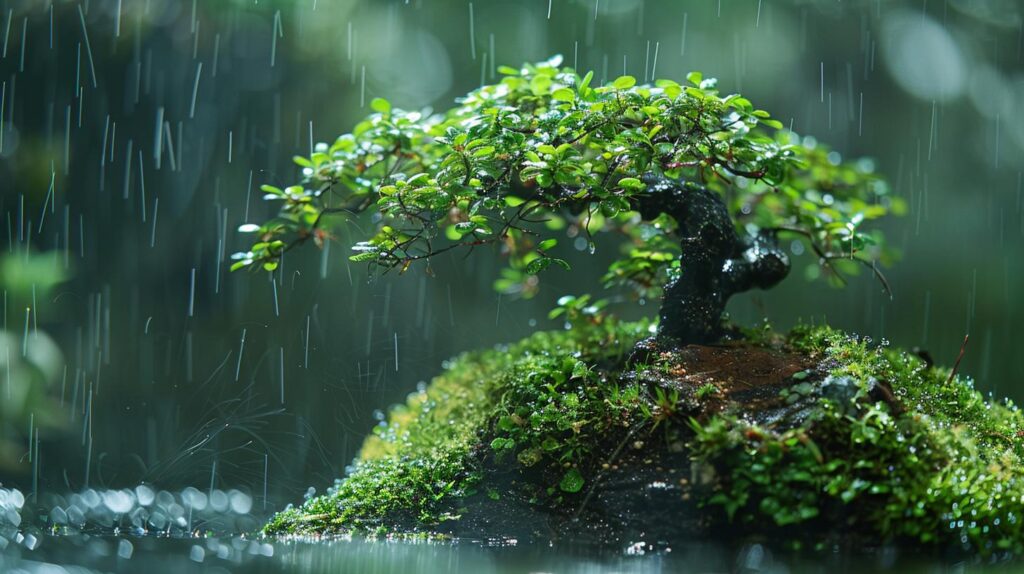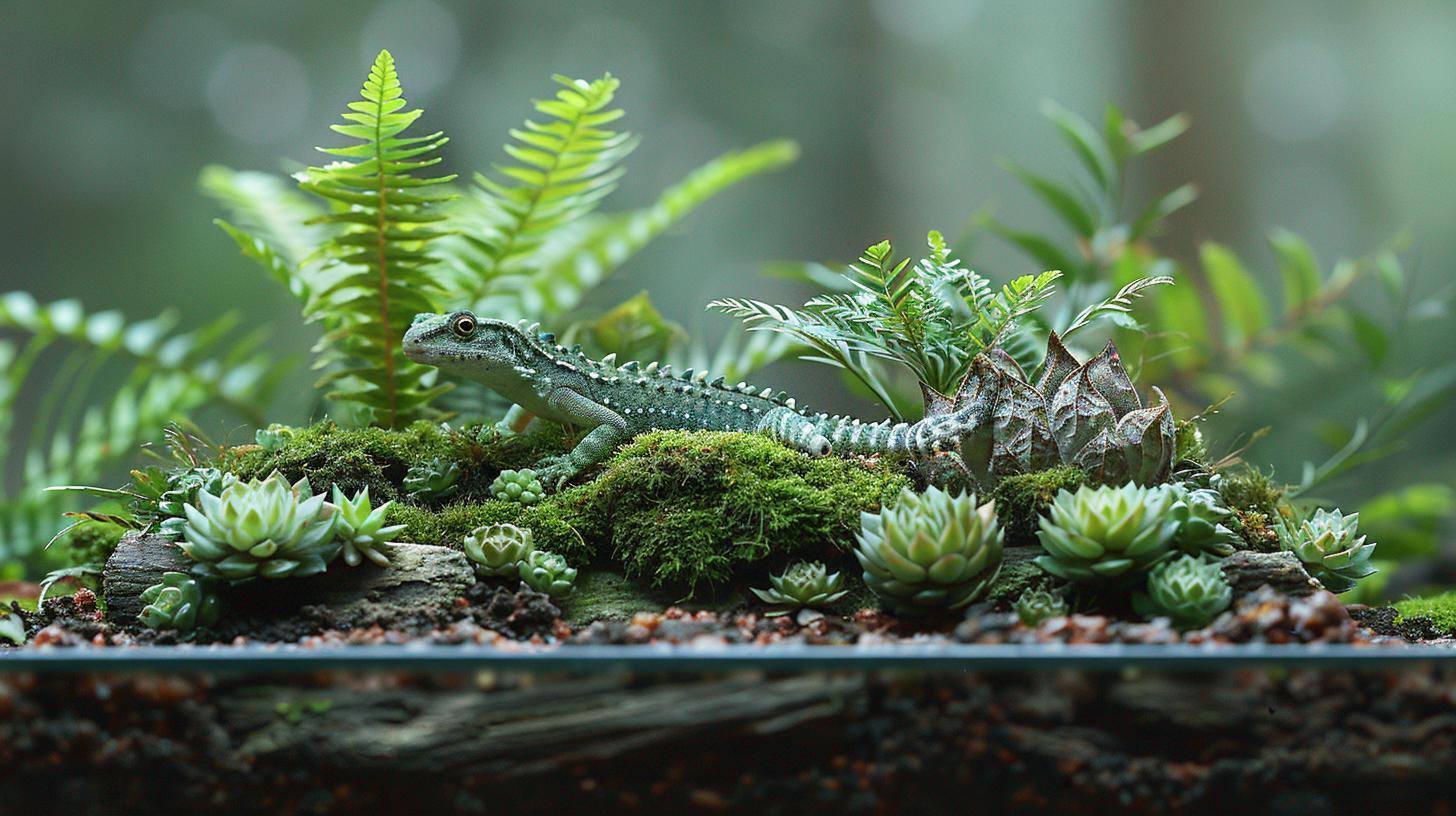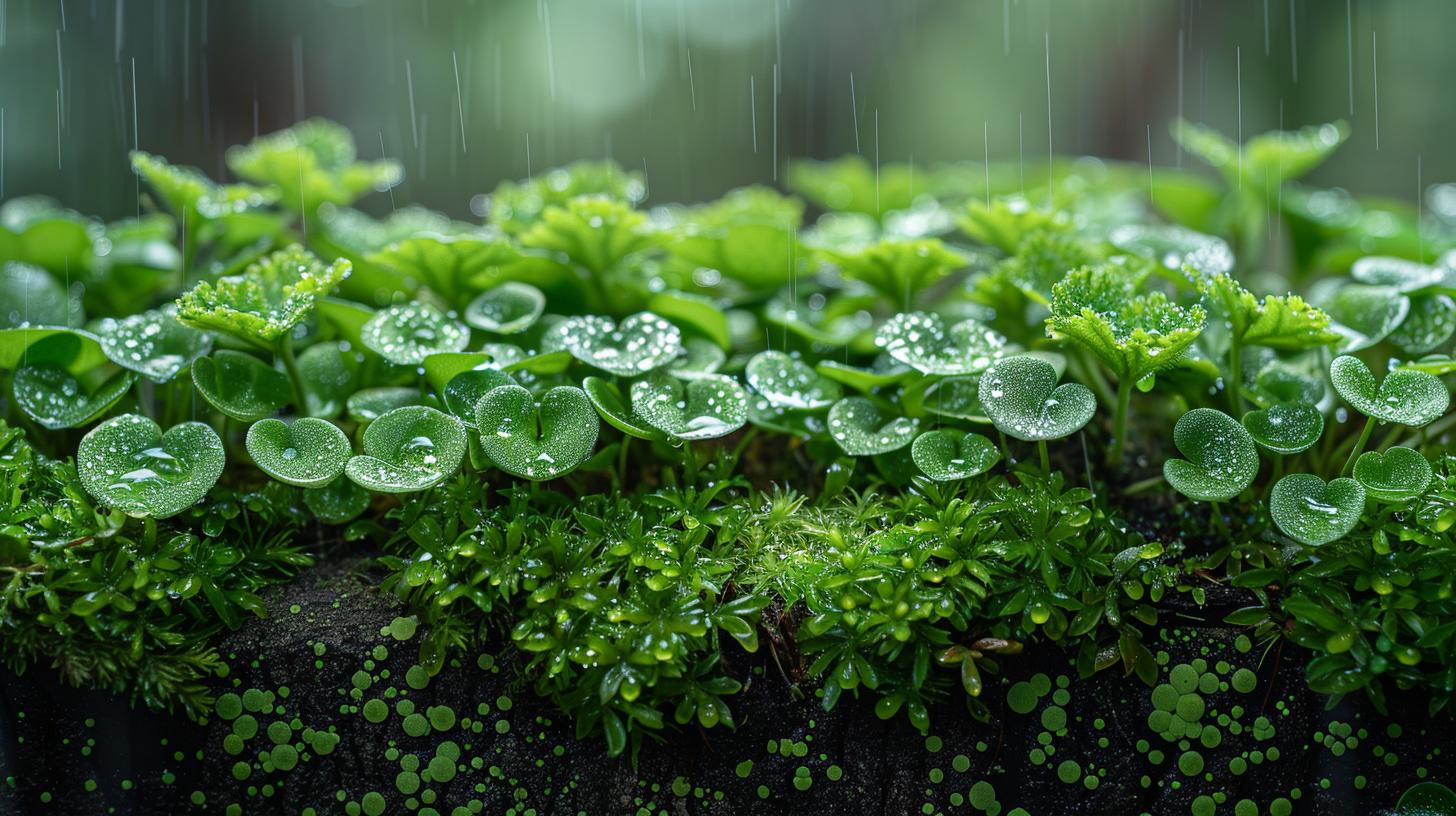What's the Ideal Humidity for Terrariums?

Unlocking the Mysteries
Terrariums, with their unique allure of creating a miniature world, have captivated enthusiasts worldwide. Key to their charm and health lies in managing terrarium humidity levels, an aspect as critical as it is intriguing.
These self-contained ecosystems not only offer a verdant snippet of nature but also present an opportunity to delve into the environmental science right on your shelf or desk. Understanding the nuanced balance of humidity within these glass enclosures reveals much about the broader natural processes at play.
The role of humidity in terrariums goes beyond mere moisture content; it's about replicating the water cycle on a micro-scale within sealed or open glass containers. Humidity impacts everything from plant transpiration to condensation patterns on the glass walls, emulating the climatic conditions each plant species thrives in. Therefore, grasping what humidity is and its pivotal function within these captivating mini-ecosystems can enhance both the vitality of the plants and the aesthetic value of a terrarium.
Different types of terrariums-tropical, desert, and temperate-require distinct humidity needs Each setup aims to mimic specific native habitats, from lush rainforests with high moisture levels to arid deserts that demand drier conditions.
The accurate setting of terrarium humidity levels can be the difference between flourishing life and stagnant growth or decay. This section embarks on elucidating how various terrarium types interact with dynamic atmospheric moisture and how enthusiasts can achieve that perfect humid haven for their green companions.
The Science of Humidity in Terrariums
Understanding the phenomenon of humidity within a terrarium is crucial for the creation and maintenance of these miniature ecosystems. Essentially, humidity refers to the concentration of water vapor present in the air, a component that plays a critical role in determining the health and vitality of a terrarium's inhabitants.
This balance of moisture is not only vital for plants' physiological processes but also influences the overall microclimate within the glass walls. The encapsulated nature of terrariums means this factor becomes even more pivotal, as it directly impacts everything from plant growth and soil moisture levels to the occurrence of pests and diseases.
Terrariums mimic the natural water cycle on a diminutive scale. The closed system allows for evaporation-water moving from the soil and plants into the air-and condensation, where this water vapor cools against the walls and returns to the soil, akin to rain. This self-sustaining hydrologic cycle is fascinating, creating an environment that can support life with minimal external intervention.
However, understanding and controlling terrarium humidity levels is imperative. If left unchecked, humidity can either suffocate your botanical sanctuary under excessive moisture or leave it desiccated, far from its intended lushness.
Tailoring Humidity to Your Terrarium Type
The first step in mastering the science of humidity in terrariums begins with recognition-acknowledging that not all terrariums are built alike nor do they share identical humidity needs. Tropical terrariums, fashioned after rainforest ecosystems, thrive under high humidity levels that mimic their native habitat's moist conditions.
On the opposite end of the spectrum are desert terraria which favor arid conditions with significantly lower moisture content. Then there are temperate setups that sit somewhere in between these extremes, requiring moderate humidity levels to flourish.
The Role of Plants in Humidity Regulation
Plants themselves play an integral part in regulating terrarium humidity levels Through transpiration-a process where plants release water into the atmosphere from their leaves-they contribute significantly to increasing ambient moisture within their enclosed environments. This natural mechanism aids in maintaining an equilibrium but also underscores why selecting appropriate plant species according to your terrarium type is essential for balance; too many highly transpirative plants in a small space could push humidity beyond desirable limits.
Navigating through the science of humidity within these enchanting glass worlds reveals that achieving harmony involves much more than just aesthetic creativity; it demands scientific insight and careful management of environmental variables. By delving deep into how water cycles operate within confined spaces and recognizing different needs based on terrarium types, enthusiasts can ensure their miniature ecosystems remain vibrant havens for flora (and sometimes fauna), effectively capturing nature's essence in miniature form.
Types of Terrariums and Their Humidity Needs
Understanding the diverse needs of terrariums begins with recognizing the distinct types that exist - particularly, tropical, desert, and temperate terrariums. Each type simulates a specific environmental condition, necessitating unique *terrarium humidity levels* for optimal health and growth of the plants within. Grasping these requirements is essential in crafting an environment where your miniature ecosystem can flourish.
- Tropical Terrariums: These terrariums mimic humid rainforest conditions and thus require high humidity levels, typically between 75% to 90%. The moist environment supports a wide variety of ferns, mosses, and air plants that thrive under these conditions. Ensuring adequate moisture while preventing water stagnation is key.
- Desert Terrariums: In stark contrast, desert setups are adapted to arid climates, where *humidity levels* are significantly lower, usually not exceeding 40%. Succulents and cacti are the staples of these ecosystems, demanding well-draining substrates and minimal water to mirror their natural habitats.
- Temperate Terrariums: These terrariums fall somewhere in between tropical and desert ones regarding humidity requirements. Aiming for a humidity level around 50% to 70% will cater well to the needs of plants typical of temperate regions. This balance ensures that both moisture-loving and those preferring drier conditions can coexist.
Achieving and maintaining the ideal *terrarium humidity levels* tailored to your terrarium's theme demands regular monitoring. Tools such as digital hygrometers provide precise readings, enabling adjustments as necessary. This might include increasing ventilation for excessive humidity or introducing water trays under the pots to boost moisture levels in dryer setups. Remember, fluctuations in room temperature and seasonal changes can impact your terrarium's humidity; hence ongoing attention is vital.

In essence, acknowledging that each terrarium type embodies a microcosm of different climatic conditions highlights the importance of customized care routines. Catering specifically to the *humidity needs* of your chosen setup not only promotes plant health but also elevates the overall aesthetic appeal of your terrarium.
As we explore further into strategies for measuring and adjusting humidity effectively in subsequent segments, integrating our insights about various terrarium types underscores our holistic approach towards nurturing thriving miniature ecosystems within our homes or offices.
Measuring and Adjusting Humidity
Measuring and adjusting the *terrarium humidity levels* is a crucial process for ensuring the health and vitality of your miniature ecosystems. Recognizing the right tools and methods for monitoring these levels is the first step in maintaining an ideal environment for your terrarium's inhabitants. A hygrometer, which can be analog or digital, serves as an essential tool in this endeavor.
It measures the amount of moisture in the air, allowing you to keep track of the humidity levels with ease. For those delving into advanced terrarium care, investing in a high-quality hygrometer that offers accurate readings is advisable.
Once you've established a method for monitoring humidity, understanding how to adjust these levels becomes paramount. If your terrarium requires higher humidity, misting the plants and interior surfaces gently with water can increase moistness effectively. However, it's essential not to overdo it; too much moisture can lead to complications such as mold growth or plant diseases.
On the other hand, if the *humidity level* surpasses what's ideal for your setup-whether tropical, desert or temperate-improving ventilation might be necessary. This could mean opening the terrarium temporarily or installing small fans to circulate air and reduce excess moisture.
| Key Component | Method/Tool |
|---|---|
| Measuring Humidity | Hygrometer (Analog/Digital) |
| Increasing Humidity | Misting Plants/Surfaces |
| Decreasing Humidity | Improving Ventilation (Opening/Fans) |
Adopting a proactive approach towards monitoring and adjusting *terrarium humidity* not only nurtures healthier plants but also prevents potential issues that excessive moisture can cause. Through regular observation and slight modifications when needed, maintaining optimal conditions within your terrarium becomes a more manageable task.
The Impact of Excessive Humidity
In the delicate balance of creating a living, breathing miniature ecosystem, understanding and controlling the humidity levels within a terrarium is paramount. Not only does it contribute to the health and growth of the plants enclosed, but it also affects the overall stability of the environment you are trying to cultivate.
While we often focus on ensuring that our terrariums are sufficiently moist, especially for those replicating tropical or temperate climates, there's another side to this coin-excessive humidity. This section delves into the consequences high moisture levels can have on your terrarium and why keeping a vigilant eye on those levels is crucial.
Excess moisture within a terrarium might seem harmless at first glance; after all, many assume that because these ecosystems are predominantly based on lushness and growth, more water equals greater vitality. However, like with most things in life, too much of a good thing can lead to adverse effects.
The importance of regulating terrarium humidity levels cannot be overstated when considering the health of your indoor garden. It's a fine line between providing your plants with a nurturing environment and creating an overbearing one that could potentially jeopardize their sustainability.
Risks Associated With High Humidity
The primary concern with elevated terrarium humidity levels is the promotion of mold growth and fungal diseases. These unwanted guests thrive in damp conditions, where ventilation is poor and moisture accumulates unchallenged. Once established, mold and fungal infections can be challenging to eradicate and may compromise both plant health and aesthetic appeal. Furthermore, excessive dampness can lead to root rot-a condition where roots are essentially drowned due to insufficient oxygen supply from overly saturated soil mixtures.
Mitigating Excessive Moisture Concerns
Identifying early signs of high humidity issues is vital in preventing long-term damage to your terrarium ecosystem. One observable indicator includes consistent condensation on the glass walls-not just during temperature fluctuations but as an ongoing occurrence.
While a hygrometer remains an essential tool for monitoring moisture levels effectively *inside* your closed environment, visual cues should not be overlooked. Should concerns arise regarding excessive dampness within your setup, several corrective measures include increasing ventilation by partially opening the terrarium or adjusting water inputs accordingly.
By being attentive to these intricacies surrounding *humid environments* within terrariums and taking preventive actions against excessive moisture accumulation, enthusiasts can ensure their miniature ecosystems remain healthy, visually appealing, and vibrant. A balanced approach toward managing terrarium humidity levels not only mitigates risks associated with surplus moisture but also enhances the overall well-being of these captivating indoor gardens.

Keeping Humidity in Check
Understanding and maintaining the correct terrarium humidity levels is essential for a thriving miniature ecosystem. This delicate balance, when achieved, not only enhances the growth and health of plants but also prevents unwanted issues such as mold and plant diseases. Here we delve into practical steps to ensure that your terrarium maintains its ideal humidity level, promoting a vibrant and sustainable environment.
Firstly, monitoring the humidity level within your terrarium is imperative. Utilizing a hygrometer-a device that measures the moisture content in the air-can provide accurate readings, allowing you to make necessary adjustments promptly. These devices come in various forms, including analog and digital, each offering different features to cater to your specific needs. Digital hygrometers often feature temperature measurements as well, giving you a more comprehensive understanding of your terrarium's climate.
- Tools for Measuring Humidity:
Adjusting the humidity levels can seem daunting; however, several techniques can help manage moisture effectively:
1. Ventilation: Adjusting the airflow can directly impact the humidity within your terrarium. Increasing ventilation reduces moisture levels by allowing damp air to escape while drawing in drier air from outside.
2. Substrate Choice: Selecting a substrate that suits your type of terrarium is crucial. For desert setups, using materials like sand or gravel that retain less water can help maintain lower humidity levels. Conversely, tropical terrariums benefit from sphagnum moss or coco coir, which hold moisture well.
3. Water Source Placement: Strategic placement of water dishes or containers can influence localized humidity areas within your terrarium. Placing these near plants that require higher humidity can create micro-humid zones benefiting those specific plants.
These methods not only aid in achieving optimal terrarium humidity levels but also contribute to the overall well-being of your terrarium's inhabitants.
Besides routine monitoring and adjustments, it's beneficial to understand how changes outside the terrarium can affect internal conditions. Seasonal shifts often bring changes in ambient temperature and humidity; thus, what works during one part of the year might need adjustment as seasons change. Adapting to these external factors is key to maintaining stability inside your diminutive ecosystem throughout the year.
Thriving Plants and Happy Habitats
As we conclude our exploration into the ideal humidity for terrariums, it becomes abundantly clear that the secret to cultivating a flourishing miniature ecosystem lies in the careful management of moisture levels. Maintaining optimal terrarium humidity levels is more than a mere suggestion-it's an integral part of ensuring the health, growth, and vitality of your enclosed garden.
This balance acts as the lifeline for plants, mirroring the natural water cycle they would experience in their native environments. For enthusiasts and green thumbs alike, understanding this delicate equilibrium means the difference between a thriving habitat and one that struggles to survive.
Navigating through the complexities of humidity control may appear challenging at first glance, yet, armed with knowledge and the right tools, anyone can create a harmonious environment within their glass walls. From choosing the correct substrates that hold moisture well to strategically placing water sources and using hygrometers for precise monitoring, each step is a building block towards achieving that perfect microclimate.
It's vital to remember that while every terrarium type has its unique needs-from lush tropicals requiring higher moisture to arid deserts thriving with less-the principles of observation, adjustment, and patience universally apply. Addressing issues like excessive humidity head-on not only prevents detrimental effects such as mold growth but also fosters an environment where both plants and caretakers can find joy and satisfaction.
We invite you to continue your journey of discovery with us. Whether you're a seasoned veteran in terrarium keeping or just beginning to dip your toes into this enchanting world, there's always more to learn about nurturing these self-contained paradises.
Our extensive library offers insights on everything from basic care to advanced customization techniques-each article designed to equip you with knowledge and inspire your next creation. Dive deeper into our collection; let's cultivate thriving habitats together that beckon with beauty and life.
Engage further with our content: Discover more tips, tricks, and tales from fellow enthusiasts in our ever-expanding terrain of articles.
Frequently Asked Questions
Is 70% Humidity Too High for Plants?
Humidity levels around 70% can be too high for many plants, especially those accustomed to drier environments. High humidity can lead to fungal diseases and pest infestations. However, tropical plants may thrive under these conditions. It's crucial to know the specific humidity requirements of your plants.
Is My Terrarium Too Moist?
If you notice condensation on the inside walls of your terrarium for extended periods, it might indicate excessive moisture. While some moisture is necessary for a terrarium, too much can harm the plants by promoting mold growth and root rot. Proper ventilation and occasional opening of the terrarium can help manage moisture levels.
Is 100% Humidity Bad for Plants?
Maintaining 100% humidity is rarely beneficial for plants over an extended period as it creates a waterlogged environment, depriving roots of the necessary oxygen and encouraging the growth of fungi and bacteria. Most plants require a balance of moisture and air circulation around their leaves and roots for optimal health.
Do Plants Like 90% Humidity?
While some plants, particularly those native to rainforests, enjoy high humidity levels like 90%, not all plant species are suited to such conditions. This level of humidity can significantly benefit tropical species by mimicking their natural habitat, supporting their respiratory processes and overall health.
Is 90% Humidity Too High for Plants?
Although 90% humidity might support certain tropical or rainforest plants, it is excessively high for most common houseplants or garden varieties, which could suffer in such moist conditions. Too much humidity leads to dampness issues like mildew and rot, indicating that maintaining balanced environmental conditions is key for plant health.
Leave a Reply
You must be logged in to post a comment.